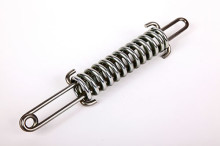Extension Springs
Contents |
[edit] Introduction
A wide range of springs are available for use in a huge number of applications, many which are not obvious. Extensions springs are just one of the types of springs that are used in everyday objects.
Extension springs are wound particularly tightly, meaning that they are loaded in tension. On each end of the spring, there is a hook or a loop, so when something is attached to each end of the spring, tension is applied and the spring attempts to bring the two items back together.
When pressure is applied to either end of the spring, the spring extends with differing tension dependent on the manipulation of the tension of the wind.
[edit] Materials
Just as with other types of springs, extension springs can be made from a range of materials including:
- High carbon steel.
- Stainless steel.
- Alloy steels.
- Non-ferrous alloys.
- High-temperature alloys.
These materials have different properties, so will be chosen according to the requirements of the spring.
[edit] Application 1: Trampolines
Extension springs are commonly used in trampolines due to their energy-storing properties. As the net of the trampoline has pressure applied by the weight of a person, tension is applied to the spring which then attempts to snap back into its original position. This allows for the action of bouncing on the trampoline.
[edit] Application 2: Toys
Very small extension springs may be used in toys that feature a throwing mechanism. The mechanism may allow for a part of the toy to be pulled back, with the release expelling enough energy to launch the item thrown by the toy.
[edit] Application 3: Prison Springs
A slightly different form of extension spring is the drawbar spring. This spring has three parts with two ‘U’ shaped wire forms being inserted into the middle of the extension spring. If the two ends of the wire forms are pulled apart, the spring is compressed. This means that there is a limit to the compression, thus making it a particularly safe spring to use in applications where this must be limited. For example, they may be used to hold safety netting between landings in prisons. The design of the spring means that should someone fall onto the netting, there would be enough movement in the spring to allow for some movement, but the spring could not extend completely which could cause the netting to collapse.
[edit] Find Out More
Related articles on Designing Buildings Wiki
- Compression Springs
- E-spring
- Spring materials.
- Key Qualities of Springs
- Spotlight on Compression Springs
- History of the Spring
- Spotlight On: Flat Springs
- The Multiple Uses of Compression Springs
- The Difference Between Tension and Torsion Springs
- The Properties of Die Springs
- Torsion Springs and Their Benefits
- Springs in Structures
- Types of spring.
--Airedale Springs 10:35, 20 Sep 2017 (BST)
Featured articles and news
RTPI leader to become new CIOB Chief Executive Officer
Dr Victoria Hills MRTPI, FICE to take over after Caroline Gumble’s departure.
Social and affordable housing, a long term plan for delivery
The “Delivering a Decade of Renewal for Social and Affordable Housing” strategy sets out future path.
A change to adoptive architecture
Effects of global weather warming on architectural detailing, material choice and human interaction.
The proposed publicly owned and backed subsidiary of Homes England, to facilitate new homes.
How big is the problem and what can we do to mitigate the effects?
Overheating guidance and tools for building designers
A number of cool guides to help with the heat.
The UK's Modern Industrial Strategy: A 10 year plan
Previous consultation criticism, current key elements and general support with some persisting reservations.
Building Safety Regulator reforms
New roles, new staff and a new fast track service pave the way for a single construction regulator.
Architectural Technologist CPDs and Communications
CIAT CPD… and how you can do it!
Cooling centres and cool spaces
Managing extreme heat in cities by directing the public to places for heat stress relief and water sources.
Winter gardens: A brief history and warm variations
Extending the season with glass in different forms and terms.
Restoring Great Yarmouth's Winter Gardens
Transforming one of the least sustainable constructions imaginable.
Construction Skills Mission Board launch sector drive
Newly formed government and industry collaboration set strategy for recruiting an additional 100,000 construction workers a year.
New Architects Code comes into effect in September 2025
ARB Architects Code of Conduct and Practice available with ongoing consultation regarding guidance.
Welsh Skills Body (Medr) launches ambitious plan
The new skills body brings together funding and regulation of tertiary education and research for the devolved nation.
Paul Gandy FCIOB announced as next CIOB President
Former Tilbury Douglas CEO takes helm.
UK Infrastructure: A 10 Year Strategy. In brief with reactions
With the National Infrastructure and Service Transformation Authority (NISTA).
























